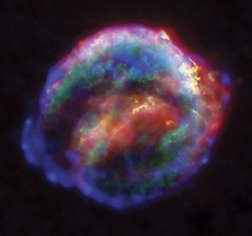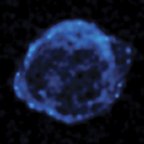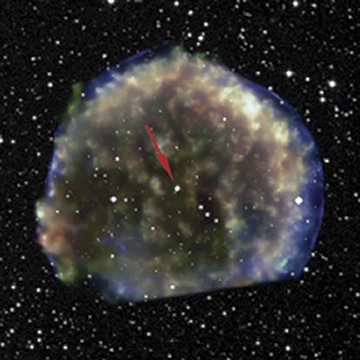On Oct. 10, 1604, a young assistant to the German astronomer Johannes Kepler looked up in the sky and saw a brilliant light that had never been there before. Located in the serpent-bearer constellation Ophiuchus, the object shone brighter than any other star in the heavens. Over the next few nights, the body grew even more luminous, rivaling the glow of the solar system’s biggest planet, Jupiter. Kepler himself got his first clear view on Oct. 17. Over the next year, he charted the course of the “new star” with naked-eye observations because the telescope hadn’t yet been invented.




Kepler’s book, De Stella Nova in Pede Serpentarii (On the New Star in Ophiuchus’ Foot), was read by noblemen and others eager to learn about the brilliant new light in the sky. Although Kepler speculated that the star’s appearance, which coincided both in time and sky location with the conjunction of Mars, Jupiter, and Saturn, might portend some important historical event, he admitted that he couldn’t explain the celestial phenomenon.
Today, astronomers know that the 1604 spectacle wasn’t the birth of a new star but the violent death of an old one. A star in Ophiuchus had blown itself to smithereens, unleashing in an instant an amount of energy equivalent to that of a billion suns. Since the 1930s, astronomers have referred to such brilliant explosions as supernovas.
Although the 1604 eruption, now known as Kepler’s supernova, incinerated within seconds, the shock wave from the blast endures. Today, it’s visible as an expanding shell of gas and dust, about 6 light-years from its source, that sweeps up and illuminates material in its path.
The 1604 explosion remains a landmark, even though modern telescopes have observed the birth of dozens of supernovas. After 4 centuries, Kepler’s supernova remains the last such eruption in our home galaxy.
Recent observations of the glowing remnant, released in time for the 400th anniversary of the supernova’s discovery, are providing new insights about what initiated this expanding shroud of gas and dust. The data are adding to the controversy over what type of star exploded to create the explosion.
At the same time, other new observations are illuminating the origin of another Milky Way supernova, which was observed in 1572 by Kepler’s predecessor, the Danish astronomer Tycho Brahe.
The supernova palette
Supernova measurements over the past decade have turned cosmology upside down, revealing that some mysterious force is causing the universe to expand at an ever-faster rate (SN: 5/22/04, p. 330: Dark Doings). Although that startling result has withstood intense scrutiny, some scientists are uncomfortable because the finding relies on observations of stellar explosions that they don’t completely understand.
Because important questions remain about why stars explode, astronomers are grateful to uncover new details about supernovas, notes Mike Shull of the University of Colorado in Boulder.
The new studies of Kepler’s supernova remnant include orbiting-telescope observations that span the electromagnetic spectrum—from very short X-ray wavelengths to long infrared wavelengths.
“Multiwavelength studies are absolutely essential for putting together a complete picture of how supernovas evolve,” says Ravi Sankrit of Johns Hopkins University in Baltimore. The gas heated to the highest temperatures by the supernova blast wave radiates X rays, for example, while cooler dust radiates at much lower, infrared energies.
This composite portrait is providing a closer look at the clumpy, filamentary nature of the remnant, a more precise measurement of its distance from Earth, and a clearer indication of the type of star that exploded to become Kepler’s supernova. The observations also reveal new information about the composition of dust kicked up by the explosion.
Visible-light images from the Hubble Space Telescope’s Ultrasharp Advanced Camera for Surveys reveal more clearly than ever before where the supernova shock wave has slammed into the densest part of surrounding interstellar gas.
The passage of the blast wave from the supernova “knocked everything out of whack,” says William P. Blair of Johns Hopkins. “The structure and the detail that we have in the Hubble data are truly remarkable,” he adds.
Clumps and filaments in the Hubble pictures mark the intersection of shock wave and dense gas. The same sort of clumpy structures form when a bottle of oil and vinegar is turned upside down. Fingers of the vinegar previously below the lower-density oil begin to fall through the oil in a pattern known as the Rayleigh-Taylor instability. In the vicinity of the remnant of the 1604 supernova, the dense pockets of gas ejected during the star’s lifetime play the role of vinegar, while the oil is played by the lower-density material propelled into space by the supernova explosion itself.
Combined with previous groundbased spectra that measured the velocity of the shock wave, the Hubble observations have yielded a new, more accurate distance to the explosion. The supernova resides 13,000 light-years from Earth, give or take about 3,000 light-years. That distance, notes Blair, will enable scientists to make more-accurate determinations of such basic properties as the diameter of the supernova and its expansion velocity.
Whereas visible-light images from Hubble reveal the densest regions of gas within the supernova remnant, infrared observations taken by the orbiting Spitzer Space Telescope discern microscopic dust particles heated by the shock wave. The blast causes the material to “radiate in the infrared like the dickens,” says Shull.
Spectra taken by Spitzer are the first to reveal that the dust has a composition similar to that of the dust that encircles young stars and provides the raw material for forming rocky planets.
“What we’re seeing is circumstellar gas and dust swept up and heated by the blast wave,” says Blair. The gas, he notes, reaches temperatures of tens of millions of kelvins,” says Blair.
Observations by the Chandra X-ray Observatory mark the current location of the hot, outer rim of the primary blast wave. Lower-energy X rays lie within a thick shell inside that rim and are produced by ionized silicon and iron atoms. The shell contains most of the material expelled by the exploded star.
Typecasting superstars
Images from Chandra, as well as spectra taken by another X-ray telescope, the European Space Agency’s XMM-Newton, are providing new clues about the kind of star that exploded on Kepler’s watch.
Astronomers divide supernovas into two main types. One class, known as type 1a, originates with a dense stellar cinder called a white dwarf, that’s the burned-out core of a star similar to the sun. A white dwarf becomes a supernova by pulling in a fresh supply of hydrogen gas either from an aging, bloated companion star or from another white dwarf with which the core has merged. In either case, when the burned-out star reaches a critical mass, about 1.4 times as heavy as the sun, its density is great enough to trigger a fusion bomb of stellar proportions.
The other main class of supernova, known as type 2, is generated by a much more massive star, at least eight times as heavy as the sun. When such a star exhausts its supply of nuclear fuel and can no longer resist the tug of gravity, its core collapses to form a neutron star, an object so dense that protons and electrons are pushed together to form neutrons. The surrounding layers of the star crash onto the collapsed core and then rebound into space. This type of supernova explosion leaves behind an ultradense, rapidly rotating object known as a pulsar. The radiation it emits sweeps across the sky, much as a lighthouse beam does.
One hallmark of type 2 supernovas is an abundance of nitrogen. Formed in the outer layers of a massive star, nitrogen is hurled into space during a type 2 explosion. A decade ago, notes Blair, the signature of nitrogen and most other evidence indicated that Kepler’s supernova belonged to the type 2 class.
But recently reported X-ray data from the XMM-Newton satellite show that the supernova’s abundances of silicon and iron are closer to those expected from a type 1a than from a type 2 supernova. Furthermore, the spectra reveal a scarcity of oxygen, neon, argon, and sulfur, elements that typically are plentiful in type 2 supernova remnants. Finally, the sharp eye of the Chandra observatory failed to find a pulsar—the clearest sign of a type 2 supernova.
For these reasons, says Blair, he and many other astronomers have reversed their thinking about Kepler’s supernova. They now propose that it belongs to the 1a class. But that still leaves a puzzle.
Unlike any other known supernova remnant in the Milky Way, Kepler’s supernova remnant lies 1,200 light-years above the galactic plane and is speeding even farther away. The disklike plane is where most stars in the Milky Way are born and die and, therefore, where most supernovas would be expected to explode.
Because of the remnant’s outgoing motion, theorists have proposed that the star that became Kepler’s supernova was, in fact, born in the galactic disk with a partner star. That partner subsequently exploded, and the remaining star sped off in whatever direction it was heading at the time of the explosion.
For that runaway star to have become Kepler’s supernova, it would have had to have been speeding out of the disk at 280 kilometers per second when its partner exploded, several research teams have calculated.
That runaway model favors the type 2 scenario—the explosion of a very massive star—as the source of the nitrogen observed in the remnant. However, the type 1a interpretation could still apply if the supernova star originally was a member of a trio, rather than a duo, of stars. First, one star could have exploded, sending the remaining pair—a white dwarf and a normal, nitrogen-containing companion star—out of the galactic disk. The white dwarf could then have pulled material from the companion before exploding into the night sky, as seen in 1604.
Having a trio of stars, a rare grouping, in which two members explode is a contrived model, Blair admits, but astronomers can test it. If the model is correct, then a surviving companion star ought to still be lurking in the vicinity of Kepler’s supernova remnant. Astronomers should search for the missing companion, Blair suggests.
Other researchers recently reported that they had found the apparent companion for another type 1a supernova, one that Tycho Brahe observed in 1572, a generation before Kepler saw the supernova that would bear his name.
Super revelations
“Amazed, and as if astonished and stupefied, I stood still, gazing,” Brahe wrote about the 1572 event in the constellation Cassiopeia. “When I had satisfied myself that no star of that kind had ever been seen before, I was led into such perplexity by the unbelievability of the thing that I began to doubt the faith of my eyes.”
The observations by Brahe and other astronomers forced scientists to abandon the notion, first touted by Aristotle, that the heavens were unchanging and immutable. In contrast to Kepler’s supernova, Brahe’s took place within our galaxy’s disk.
Researchers now report in the Oct. 28 Nature that they may have found the companion star that fed the 1572 explosion. The apparent companion is similar in mass to the sun but slightly older and considerably puffier.
The discovery supports the notion that type 1a supernovas arise when a white dwarf siphons hydrogen gas from a ballooning stellar partner. In a competing theory, the white dwarf explodes when it siphons gas from another white dwarf, with which it coalesces.
Pilar Ruiz-Lapuente of the University of Barcelona and her collaborators used several telescopes, including Hubble, to find and study the apparent companion star, which seems to be still running away from the scene of the explosion.
Hubble data show that the purported companion has an unusual velocity, moving three times as fast as other stars in the same part of the Milky Way. The scientists conjecture that the star went hurtling off into space after its white dwarf partner went supernova.
The star’s velocity and location in the sky suggest that the star is a survivor of the 1572 supernova, but there’s still room for doubt. For instance, the star could be in the same line of sight as the supernova, but reside much farther away.
However, there’s evidence that the star dwelled in the Milky Way’s disk, where the supernova originated. Spectra taken with the William Herschel Telescope in La Palma, Spain, and the twin Keck Telescopes atop Mauna Kea in Hawaii show that the star has an abundance of heavy elements typical of stars in the Milky Way.
“If we accept the notion that the companion [of the 1572 event] has been identified, we now know for the first time that not all types of type 1a supernovas are produced by the coalescence of white dwarfs,” says David Branch of the University of Oklahoma in Norman. He suggests that astronomers should now look for evidence that the star’s atmosphere has been polluted with material hurled into space by the supernova. “This would clinch the case that Tycho’s companion has been found at last,” he adds.
With a supernova typically popping off in our galaxy about once a century, the Milky Way is long overdue for an explosion such as witnessed by Brahe and Kepler. The next Milky Way supernova will face an armada of telescopes documenting the explosion in exquisite detail from the very beginning, and scientists will likely follow its remains for centuries to come.







